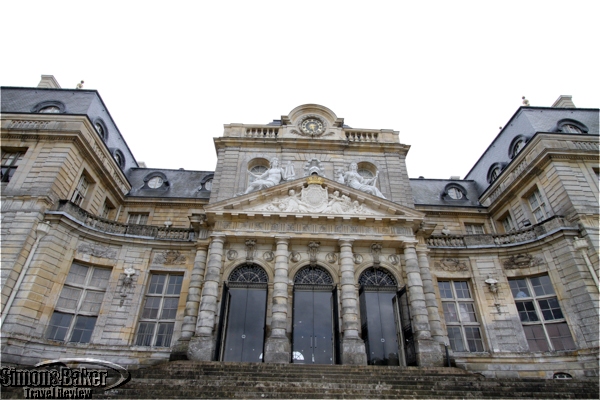
by Editor | Mar 6, 2017 | Attractions, Food, Luxury Travel, Spas
By Elena del Valle
Photos by Gary Cox
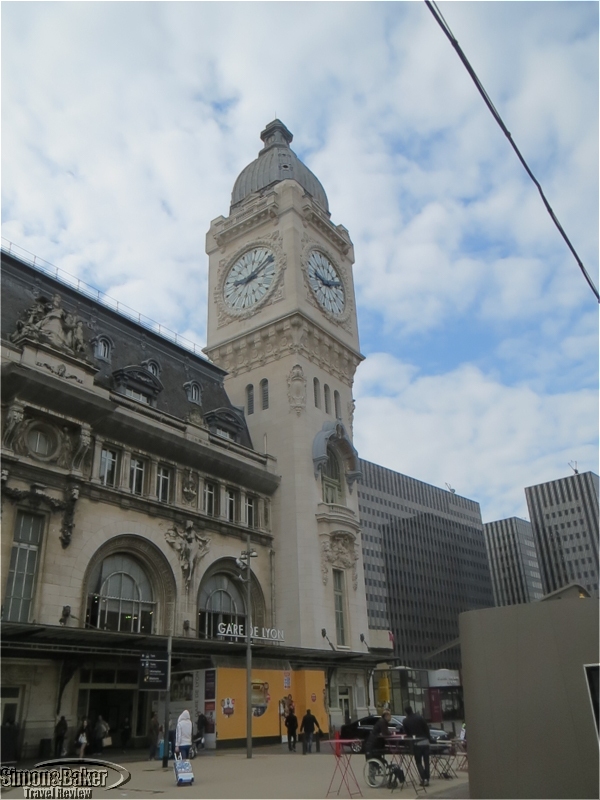
The Gare de Lyon train station in Paris
During a spring visit to Paris, France we went on an overnight side trip to the Seine-et-Marne Department (www.turisme77.co.uk and www.paris-whatelse.com) for the first time. To get there we took a train from the Gare de Lyon in the twelfth arrondissement of Paris to Melun, a city in the Seine-et-Marne. From there we made our way around by car from the train station to the area villages where, despite cold and rainy weather, we explored museums, chateaux, an artist village, a spa, and a pastry shop, spending the night at the La Demeure du Parc, a four-star boutique hotel within walking distance from the Château de Fontainebleau (Fontainebleau Castle), a museum and former royal residence.
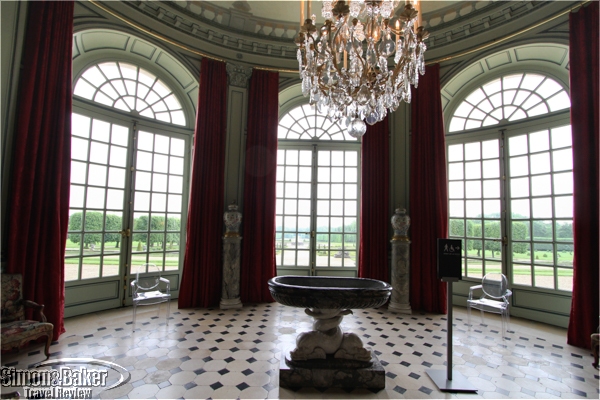
The rotunda inside the Château de Champs-sur-Marne looking out on the gardens
Our first stop was the Château de Champs-sur-Marne (see Eighteenth century home museum near Paris worth visit when in Seine-et-Marne area), a 16 room two story structure completed in 1708. Known for its rococo style and its Notable Gardens the former family home had been converted into a museum managed by the French government. After a guided tour in English of the Château de Champs-sur-Marne, we had lunch and a short guided tour in English of the Château de Vaux-le-Vicomte, a private estate open to visitors and my favorite attraction overall. Even when compared with grand former royal residences the property’s historic character, artistic harmony and beauty stood out. Before leaving and despite the ugly weather we made our way around the beautiful gardens in an abbreviated self-guided exploration.
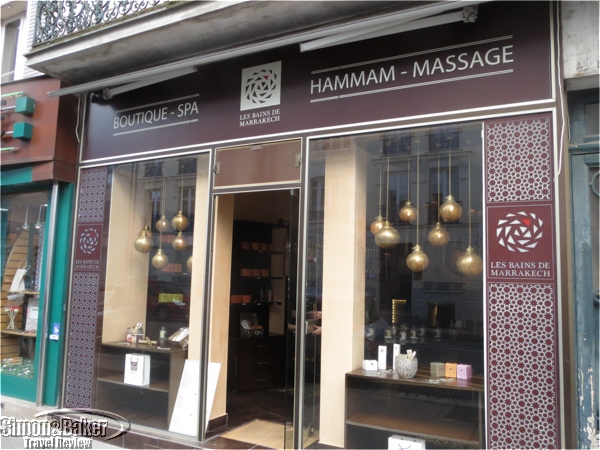
Les Bains de Marrakesh in Fontainebleau
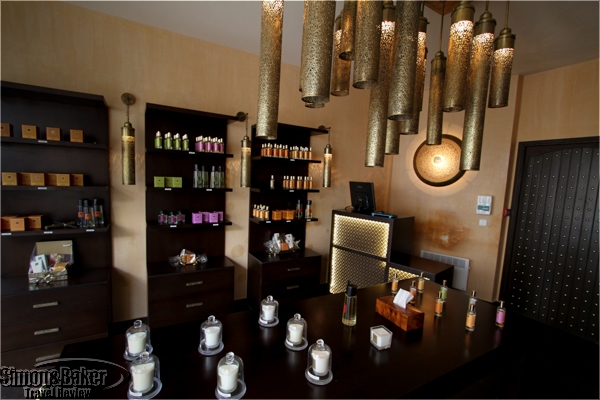
The shop at Les Bains de Marrakesh
Before checking into our hotel we had a massage at Les Bains de Marrakech (186 rue Grande, 77300 Fontainebleau, +33 09 81 13 17 21, lesbainsdemarrakech.com, fontainebleau@lesbainsdemarrakech.com). Because we arrived late our massages were cut short. Despite that the staff members were friendly and welcoming. The small facility was spotless and quiet.

The war memorial in Barbizon
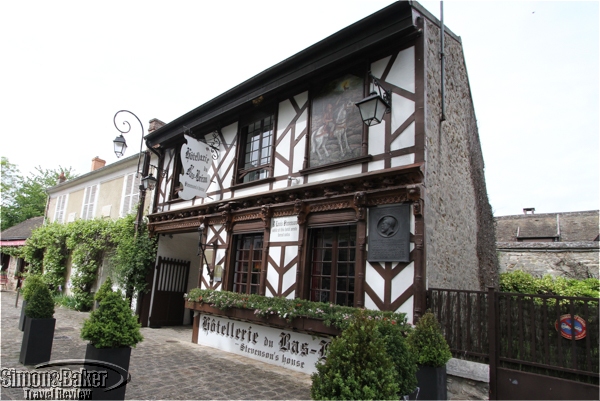
The house of Robert Louis Stevenson
Dinner (and breakfast the following morning) at our hotel was excellent. In the morning, we met Véronique Villalba, our English speaking guide in front of the Fontainebleau Castle, a former residence of the French monarchy, for an excellent tour. Following lunch, we headed to the charming artist Village of Barbizon, about seven miles northwest from Fontainebleau. We walked around with umbrellas in hand, exploring the touristy main street and admiring the pretty facades. We popped into Le Musee des Peintres de Barbizon (the Museum of Painters of Barbizon). Although it was crowded at times we enjoyed our visit thanks to our guide’s insights and engaging discussion.
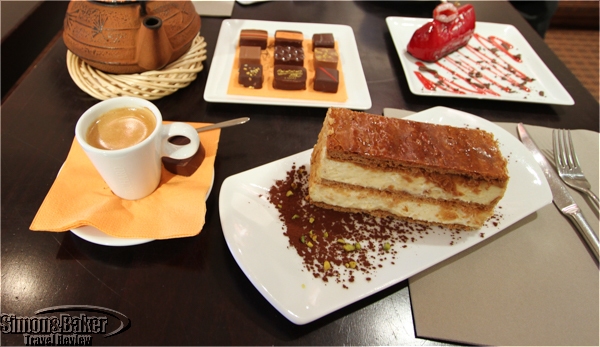
Tasty treats at Frédéric Cassel, Fontainebleau
On our way back to our hotel we stopped at Frédéric Cassel Fontainebleau (71-73, rue des Sablons, 77300 Fontainebleau, +33 01 60 71 00 64, www.fredericcassel.com), a shop in the town’s popular pedestrian shopping street for espresso, tea, chocolates, and pastries. We had a Vanilla Millefeuille and an Ilanka pastry, a worthwhile sweet ending to our pleasant visit, before our taxi drove us back to the small train station, where we boarded the crowded train back to Paris.
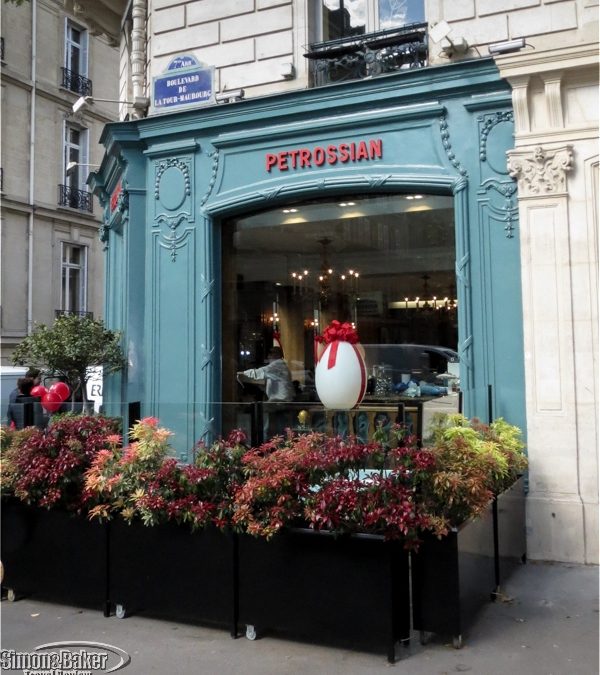
by Editor | Nov 27, 2016 | Food, Luxury Travel, Restaurants and Food
Article by Elena del Valle
Photos by Gary Cox
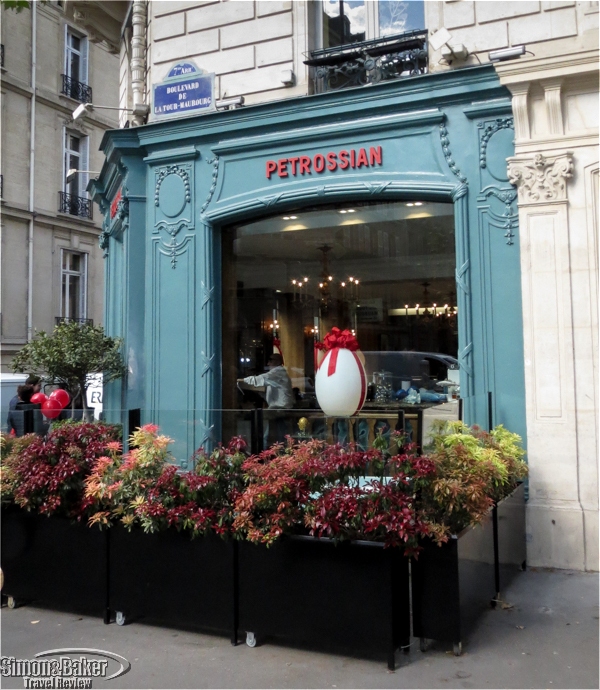
The Petrossian shop window on Boulevard de la Tour-Maubourg
Ever hear of Daurenki Impérial, Baika Impérial, Ossetra Impérial, Alverta Impérial, and Beluga Impérial? If you are a foodie you may already have an idea of what the names are, the types of farmed caviar some of which we tasted at the popular Petrossian Latour boutique in Paris, France owned by Armen Petrossian (18 boulevard de la tour Maubourg 75007 Paris, + 33 14 411 32 22, www.petrossian.fr, boutique@petrossian.fr).

Philippe Vanlacker described the types of caviar before we tasted them
On a cloudy spring morning we made our way, braving streets filled with protesters and police, to the Petrossian shop in the city’s Latin Quarter, where we sampled various products. Philippe Vanlacker, a friendly English speaking staff person, welcomed us and facilitated the caviar, Royal Salmon, and Kamtchatka Crab tasting. We liked that the only added ingredient was sea salt. There were no preservatives or additives, according to a spokesperson.
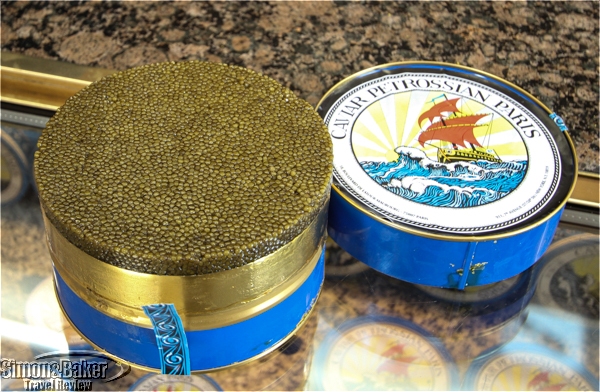
A kilogram of fine caviar
The caviar we tried, made from fish eggs and sea salt only, came from China, France, Israel, United States, and Bulgaria. The farmed salmon was from Scotland and the crab, previously frozen, was from Russia. The shop, about 600 square feet in size and staffed by eight people, appeared to be mostly for takeout purchases although it also had a few tables and a limited menu for customers wishing to have a light dish onsite. Our entire tasting was conducted while we stood facing the waist high counters without beverages of any kind.
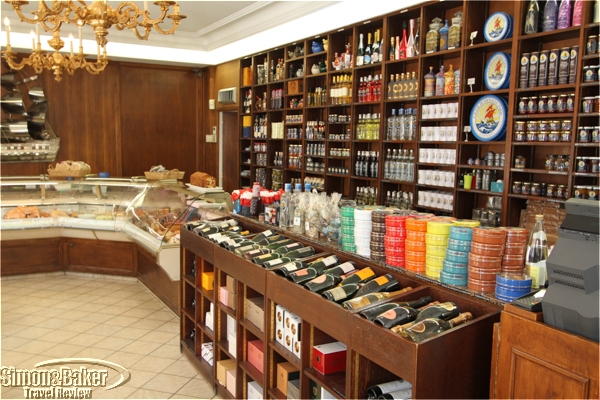
The interior of the shop
When we asked about the advantages of a store tasting a spokesperson explained by email, “When somedy (somebody) bring caviar home, it means that the man or the woman wants to seduce his/her partner or guest. But most of the time, he/she doesn’t know if they will like it. When they taste in the boutique, the can choose the caviar they have prefered (preferred) because they can taste differents (different) caviars. This is the big difference between internet, the others caviar houses and Petrossian: it’s the only place where you can taste the caviar before buying it.”
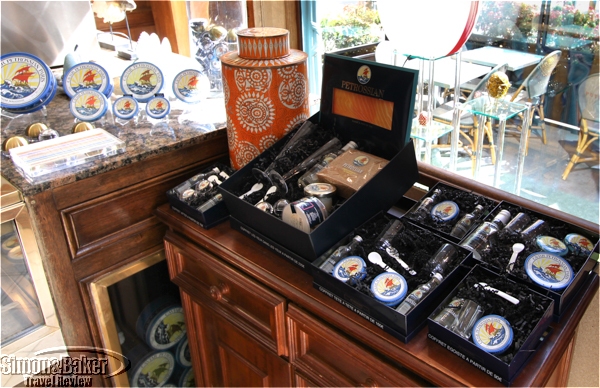
There were gift packages to accompany the caviar
Established in 1920 the shop draws local and international visitors the staff explained, saying that many people visit the boutique like a museum and stop to take photos. Some of the staff, including Joseph, Lorna and the owners, have been there for more than 30 years. Everything in the boutique is homemade and fresh, a spokesperson explained by email, adding, “Tourist come from all around the world because they know Petrossian. They want to bring back home a little souvenir, a little gift, and most of the time, they choose caviar because we offer them a cool bag with dry ice inside and they can travel with it.”
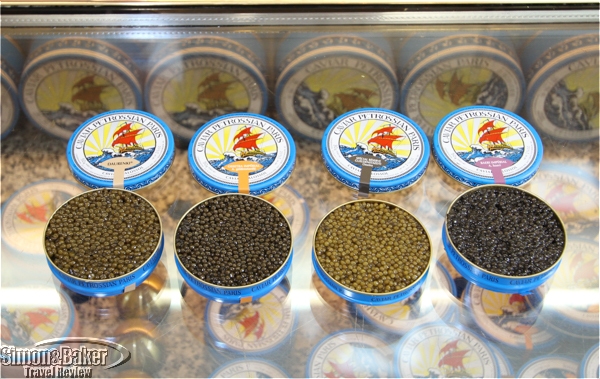
The staff person selected a single bite for our tasting from four caviar varieties sold in the metal containers pictured above
We liked the opportunity to sample the delicate products with the guidance of experts so that the caviar we tasted was at just the right temperature and optimum conditions. Too warm and the flavor is spoiled, too cold and it fades, the shop employee explained. The ideal temperature to taste caviar is between 6 and 8 degrees Celsius, he said. Being able to compare and contrast the nuances from one type of caviar to the other was an added advantage as it allowed us to form an opinion from the single tasting serving without having to purchase and prepare a tasting at home.
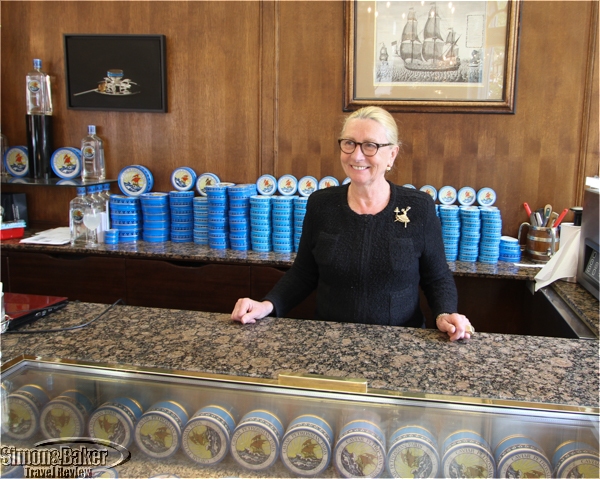
Cécile Petrossian supervised the tasting
We began the gourmet experience, under the supervision of Cécile Petrossian, Armen Petrossian’s gracious and elegantly attired wife, with caviar. While we watched our host pulled out tins from the glass counter before us, explaining the basics about the caviar, which was between eight and twelve months old. He used a special key to open the large cans such as a two kilo Ossetra Reserve container filled with plump sturgeon eggs he showed us before retrieving our sample from a small tin. Philippe handed each of us one serving of several types of fish eggs on disposable wood sticks, explaining wood and mother of pearl are commonly used to avoid distorting the delicate flavor with metal spoons. We were surprised at the slight variations in color, texture and taste of the caviar samples, light and smooth yet each with a distinct characteristic. One was dark, almost black with a hint of fish and salt. The Ossetra Reserve was dark gold and more defined. The Ossetra Impérial eggs were firmer than the Ossetra Reserve with a more pronounced flavor. And the final sample, also with a gold hue, reminded me of the sea yet had a fattier yet subtle taste.
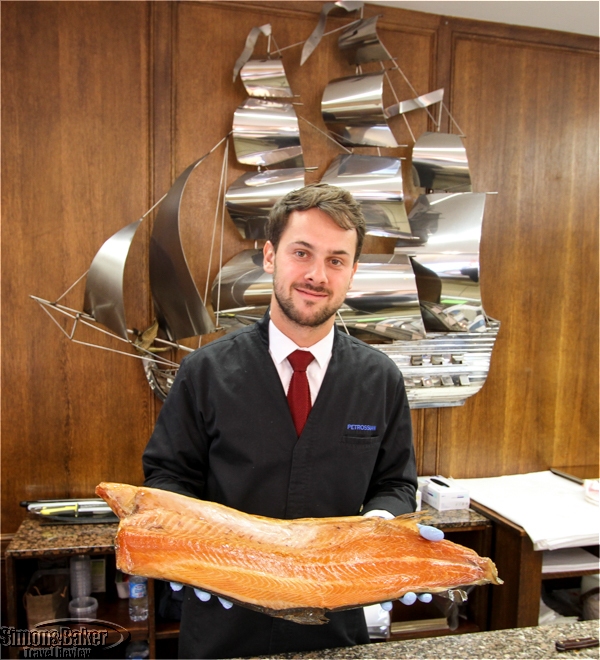
Phillipe displayed a smoked salmon chunk before slicing a sliver for our tasting
At the conclusion of the caviar sampling, we crossed to the opposite end of the shop to the salmon counter, where we sampled several flavors such as Caucasienne, Nature, and Bettrave. All were buttery in texture and seemed to melt in the mouth. Philippe explained their salmon was smoked and aged hanging so the excess fat could drip naturally and allow the remaining flavor enhancing fat to cling to the fish, lending it a rich yet understated taste and texture. We sampled the salmon “tenderloin” in three flavors. The Nature salmon was just that natural. The Caucasienne was prepared with a rub of 12 spices. And the Bettrave was colored with beetroot juice, which made it look like raw tuna. To crown the experience Philippe handed us a bite of Kamtchatka Crab followed by a dollop of the house tarama (fish egg spread).
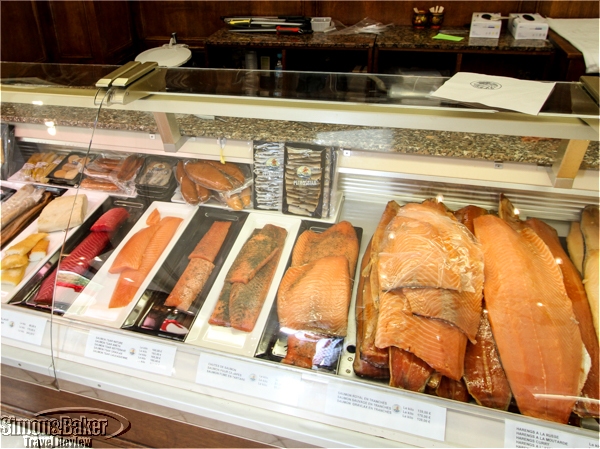
Several varieties of salmon, some with special marinades like beet root
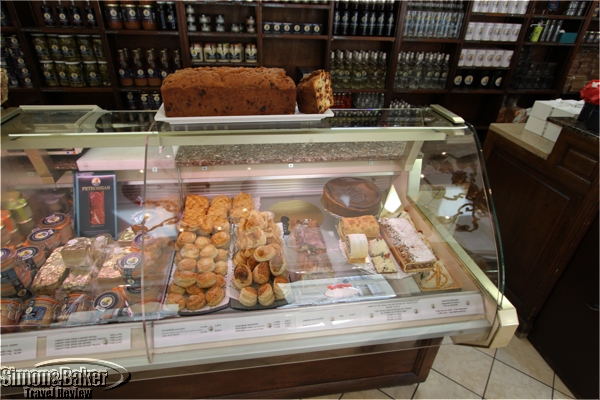
There were prepared specialty foods
We liked the shop’s caviar and salmon selection and expertise and will recommend it to friends wishing to taste the specialty foods in a gourmet environment. The staff’s warm service in English enhanced the experience and would draw us back easily.
by Editor | Oct 24, 2016 | Attractions, Luxury Travel
By Elena del Valle
Photos by Gary Cox

Fontainebleau Castle from the gate
During a spring trip to Paris, France we visited the nearby town of Fontainebleau, in the Seine-et-Marne Department (www.turisme77.co.uk and www.paris-whatelse.com), known for its former royal residence and forest. There was too much to see in one day so we spent the night at La Demeure du Parc, a boutique hotel established in late 2015 that was conveniently located within easy walking distance from Fontainebleau Castle.
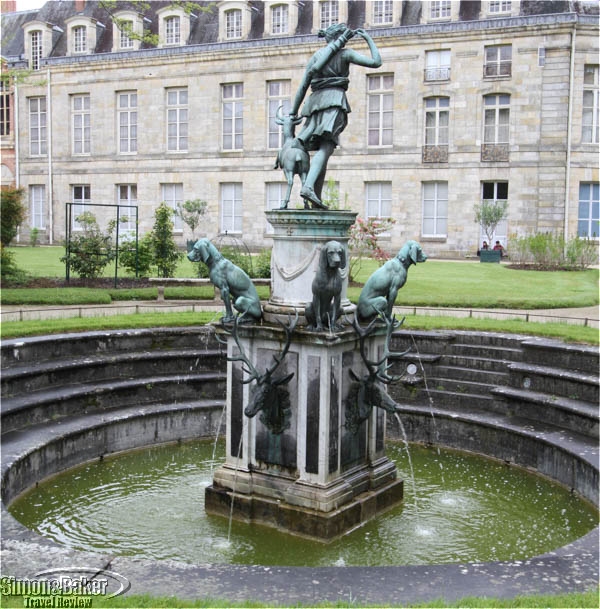
During our tour we walked past one of the water fountains named for Diana
Since our time was short and it was our first visit to the area we took advantage of the opportunity of a guided tour in English. We met Véronique Villalba (v.villalba@laposte.net), our licensed guide, at 10 a.m. in front of the castle for Les Grands Appartements Tour, a private two-hour visit of Fontainebleau. A graduate of the University of Nanterre specializing in art history she had 10 years of experience as a guide. It was her friendly demeanor and passion for history that brought the former castle stories to life and made our morning activity memorable.
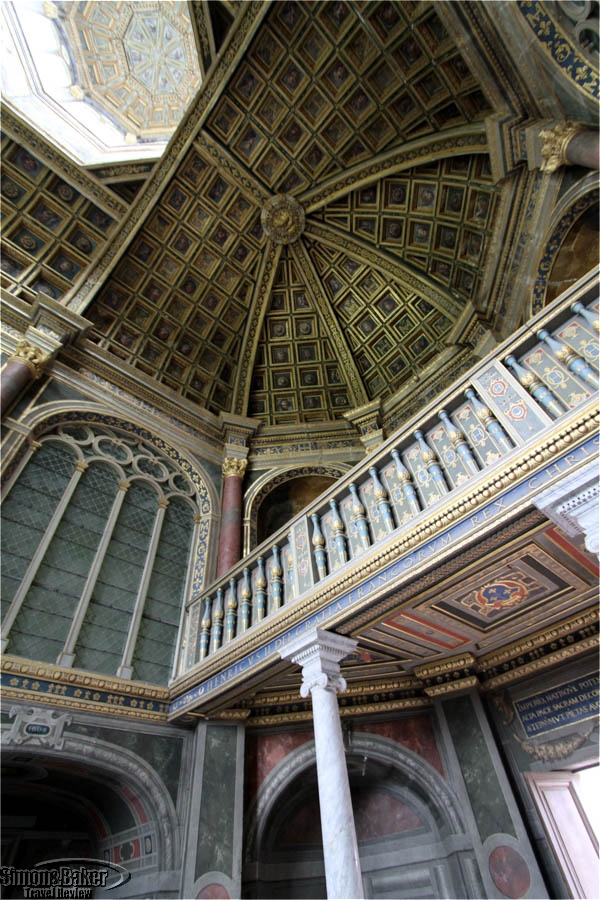
The interior design varied according to the time period of construction.
When I asked her why the historic attraction was special she explained that it was the sole castle that housed French kings for more than eight centuries (taking into account an interruption due to the Hundred Years’ War). In contrast, she explained, Versailles only served that purpose for four centuries and the Louvre had only become a royal home 650 years earlier.
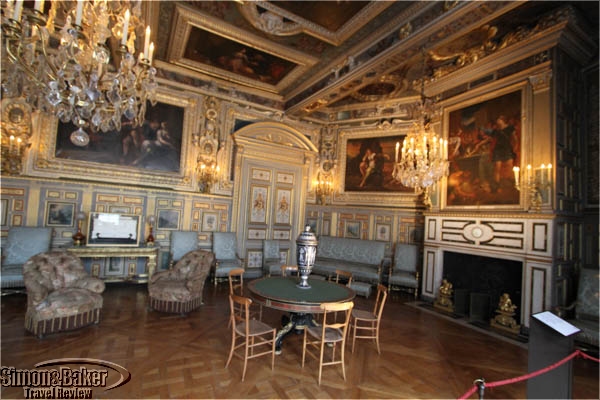
One of the characteristics worth noting was that the castle retained period furniture
Fontainebleau Castle, established circa 1137, was large. The fortified complex occupied 46,500 square meters of space in 13 floors, which included 1,536 rooms. Of those, 6,000 square meters were open to the public. It had 130 hectares of parks and gardens with 42,500 plants, and employed 135 staff. Despite the chilly and rainy weather we encountered it was by no means devoid of visitors. On the plus side, with only 470,000 visitors in 2015 it was a much more serene attraction than the Louvre or Versailles, both of which had millions of visitors a year each.

The Grand Salon de l’Imperatrice
The attraction itself was made up of a hodgepodge of buildings, improved and modified on the whims and budget strings of its powerful owners over the years. Despite our brief visit we toured interior and exterior areas. That the interior rooms were frequently furnished with original pieces, she explained, lent the castle a notable ambiance absent in other castles and palaces where the furniture and art had been sold years earlier.
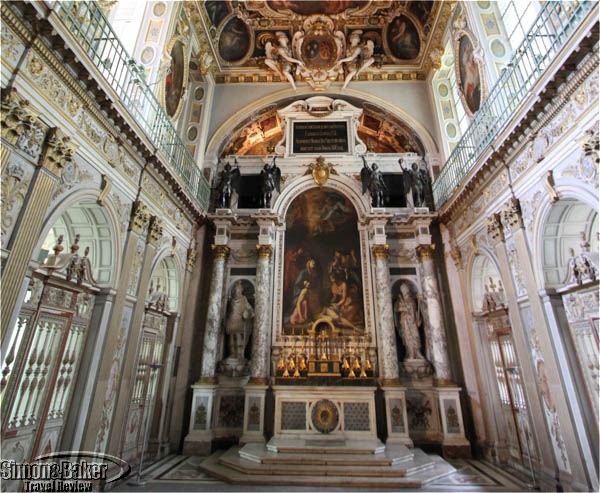
The Chapelle de la Trinité
We visited the Royal apartments, Renaissance Rooms, one of Marie Antoinette’s Boudoirs, Francis I Gallery, Galerie de Diane, Chapel of the Trinity, Chapelle basse Saint-Saturnin (only the upper level). We saw many of the masterpieces: The Duke of Orléans Commemorative Wedding Cabinet, Charlemagne in the Guise of Henry IV (in the Chapelle de la Trinité), The Royal Elephant (in the Galerie François Ier), Alexander Taming Bucephalus (in the Galerie François Ier), Odyssey Cabinet (in the Ancienne Chambre de la Reine), Beneman Commode (in la Nouvelle Chambre de la Reine), Marie Antoinette’s Bed, Napoleon’s Throne. Outside we walked through or caught a glimpse of its gardens and courtyards (sometimes from a distance): Cour Ovale, Cour de la Fontaine Cour d’Honneur, Cour des Offices, Grand Parterre (created by André Le Nôtre and Louis Le Vau and said to be Louis XIV’s greatest architectural achievement at Fontainebleau), Jardin Anglais, Jardin de Diane, Grotte des Pins, Pavillion de l’Étang, and Park. Should I return to Fontainebleau I would enjoy another visit to the castle, especially in the company of Véronique Villalba, for further discovery and leisurely exploration, including time in its gardens if the weather is clear.
by Editor | Sep 12, 2016 | Attractions, Luxury Travel, Restaurants
By Elena del Valle
Photos by Gary Cox
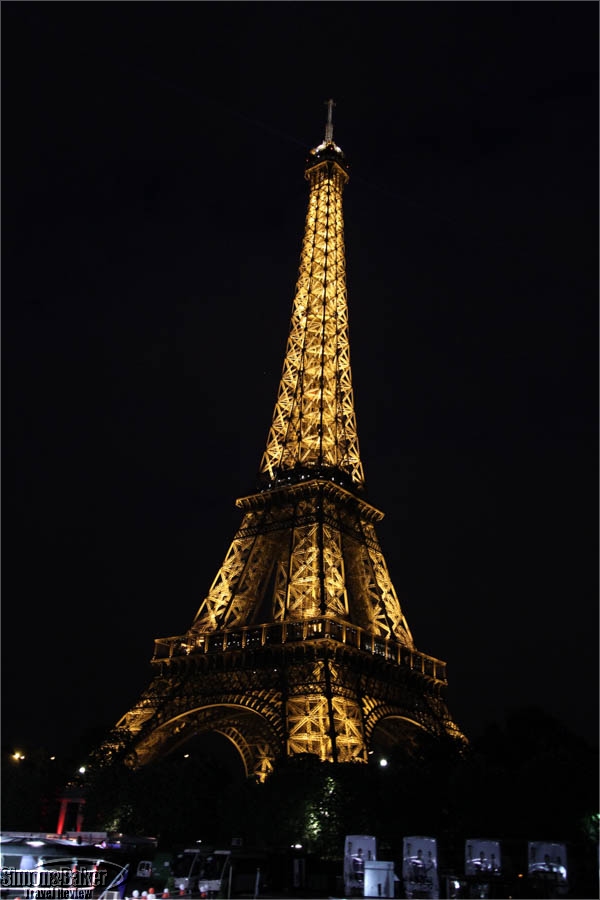
Our view of the Eiffel Tower as we cruised by on the Seine River
Often friends and acquaintances, knowing my fondness for Paris, France ask for dining recommendations. It is a question I never take lightly, especially for first time visitors. One of my top recommendations is Le Jules Verne in the middle of the world famous Eiffel Tower because of the romantic setting, gourmet offerings and spectacular views of the city. It is the type of setting that memories that last decades are made of and the perfect place for special occasions.
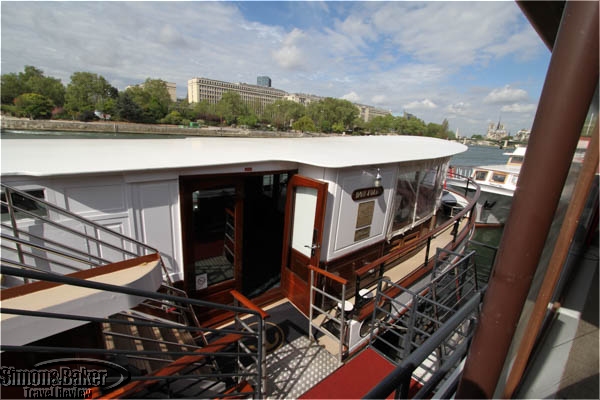
The boarding area of the yacht Don Juan II
On my most recent visit, I discovered another completely different yet equally romantic, elegant, and memorable venue, the Yachts de Paris Don Juan II (Port Henri IV, 75004 Paris, France, +33 1 44 54 14 71, http://donjuan2.yachtsdeparis.fr/ , reservations.dj2@ydp.fr ), a 50 meter long by 7 meter wide yacht. Aboard the vessel, which could seat 38 guests (far fewer than the famous iconic tower), five staff served an appetizing set menu made from fresh ingredients while the boat cruised 26 kilometers along the Seine River past the Eiffel Tower and back to its departure dock, a stone’s throw away from the Ile Saint Louis in the heart of the city. There were only 12 of us that night, which made the experience ever more intimate and special.
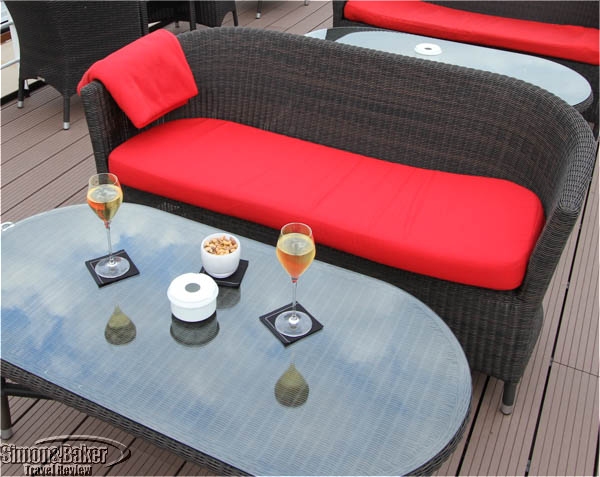
Before our departure we sat on at a comfortable spot on deck to enjoy views of Notre Dame while sipping a bubbly aperitif
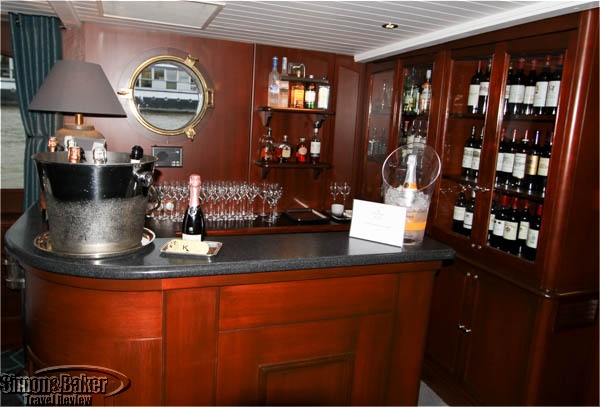
Below deck the bar was stocked with several types of champagne
Despite our early arrival we received a warm welcome by the English speaking staff. We were immediately invited to board. Black rattan furniture with red cushions was spread around the open space atop the Don Juan II. Below deck pretty tables were set and awaiting our arrival. The elegant tableware was designed by Safran and the furnishings were by Pierre Frey. The single stall head was spotless. After a quick tour one of the staff invited us to have an aperitif topside while we waited for the rest of the passengers to arrive.
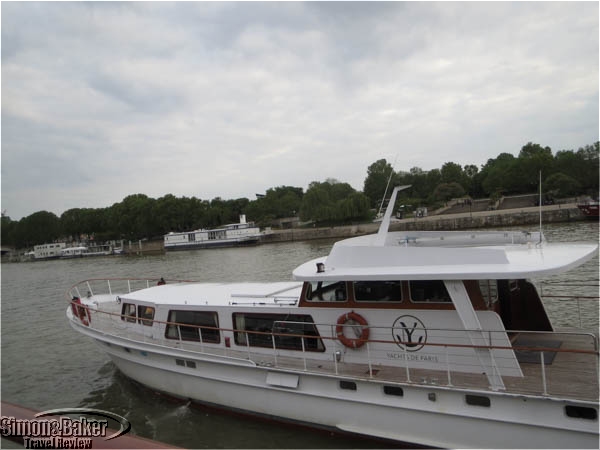
Another Yacht de Paris vessel passed just as we pulled out onto the river
Moments later, we were sipping chilled champagne and munching on mixed nuts (pistachios, cashews, pecans, walnuts and Brazil nuts) and enjoying views of Notre Dame Cathedral, the Institute du Monde Arab, and the Left Bank as the rest of the guests began to arrive. Francois, an attentive staff member, offered me a synthetic fiber red blanket to ward against the night chill. He brought us bite size morsels of salmon with beetroot, tomato and radish. Greg, the cruise photographer, introduced himself and with our permission took some photos. When it was departure time our server invited us below deck. We headed to our window side table for dinner.
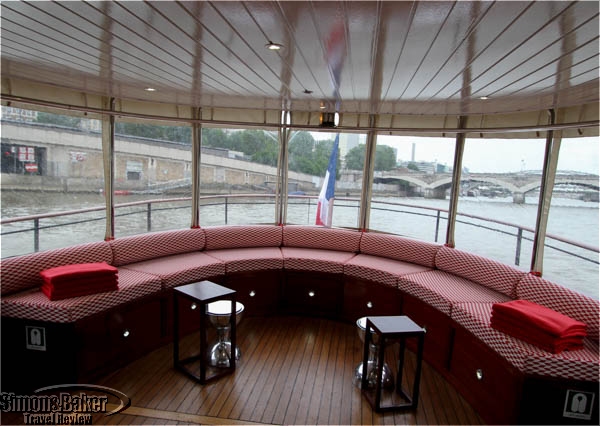
The aft view of the river
From the Port Henri IV we motored past the Ile Saint Louis and Ile de la Cite islands passing many historic buildings such as the Conciergerie, Musee du Louvre, Grand Palais, small Statue of Liberty, Eiffel Tower (at the top of the hour to see the twinkling lights), the Musee d’Orsay and finally Notre Dame Cathedral. The Don Juan II glided gently along the river most of the way, so that but for the passing scenery and the occasional wake from a fast moving boat we might have forgotten we were on the water.
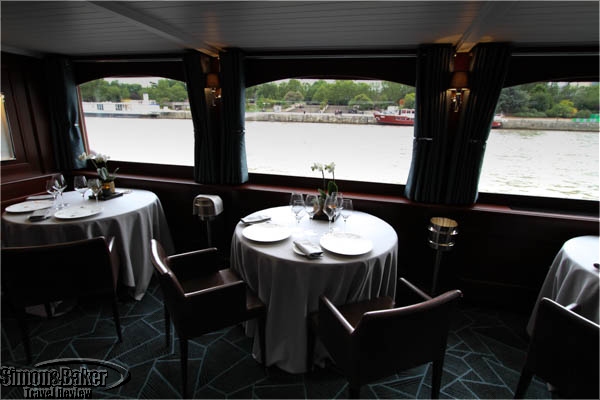
We had an outstanding view thanks to the yacht’s large windows
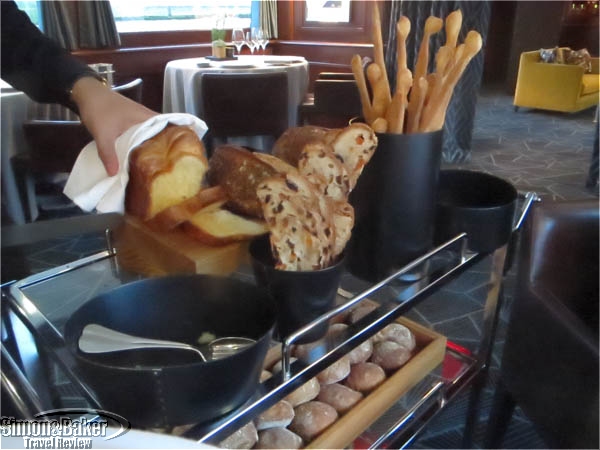
The bread cart was one of several luxury features of the dinner service.
Our five course set menu dinner began with a pre-starter of Crab, white radish pickles, chips and crisps. There were two types of butter, salted and seaweed flavored. A server came by our table to offer us bread from a cart: country, fruit and nut, Italian bread sticks, brioche. Whenever our bread plate was empty she would return to refresh it with our selections. Lobster with fresh greens and creamy nage was next. The main course was Suckling Lamb, roasted and cooked with bay leaf, organic asparagus from the Landes with juice and Parmesano di Reggiano cheese. A Saint-Nectaire cheese course followed. For dessert we had Flower of flowers, lime and strawberry cremeux and juice of an infused hibiscus. Chocolate bites, presented in individual boxes for us to keep, completed the repast. Our meal was paired with a 2012 Louis Jadot chardonnay from Burgundy. We appreciated the souvenir printout of our menus. It included a map of our path along the Seine.
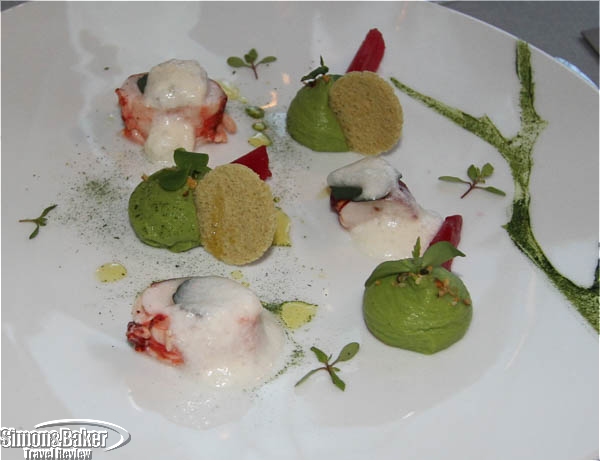
The art like pre-starter featured bites of crab
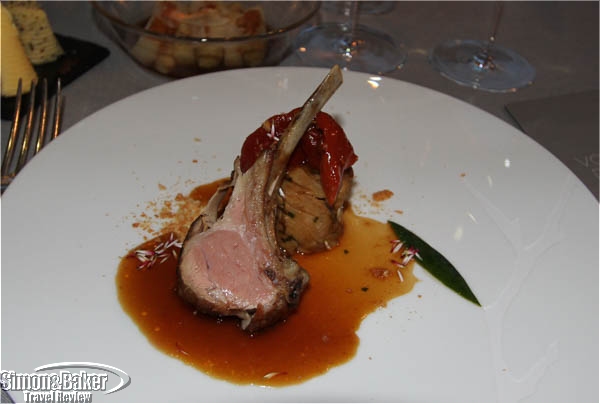
The suckling lamb
The photographer took our photos with iconic buildings in the background such as Notre Dame while we were docked and later the Eiffel Tower when we went topside to enjoy the light show during the cruise. At the conclusion of the cruise the photos were available for purchase. Our two favorite photos became a lovely keepsake that enhances our wonderful memories of the evening.
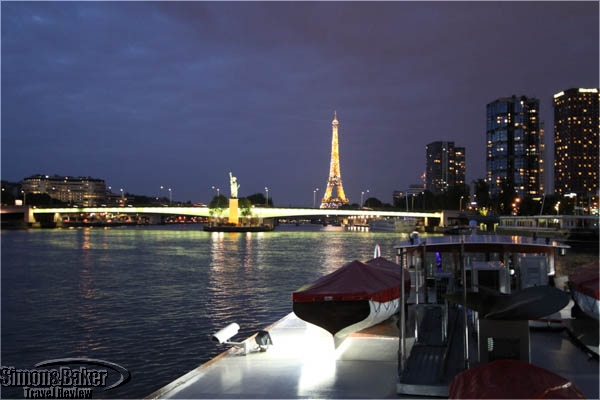
Among the sightseeing highlights were the Pont de Grenelle replica of the Stature of Liberty and the Eiffel Tower
The restaurant, opened March 2003 and managed by François Giroud, was one of eight small vessels owned by Yachts de Paris. The meals were created by Guy Krenzer, executive chef, who was recipient of the recognition Double Meilleur Ouvrier de France and creative director of well known Lenôtre culinary enterprise. The wine and food pairings were selected by Olivier Poussier, recipient of the Meilleur Sommelier du Monde 2000 award.
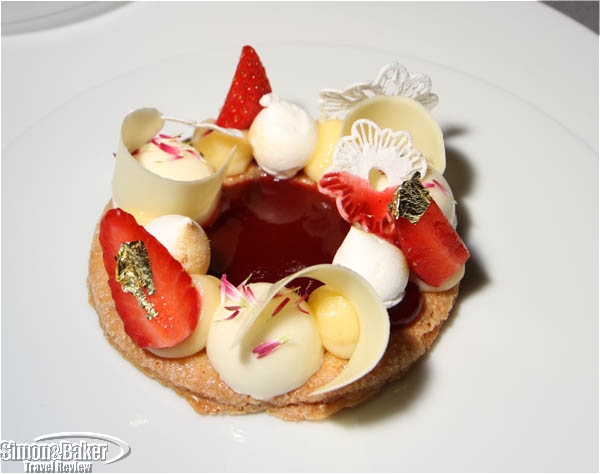
The colorful dessert of Flower of flowers, lime and strawberry cremeux and juice of an infused hibiscus
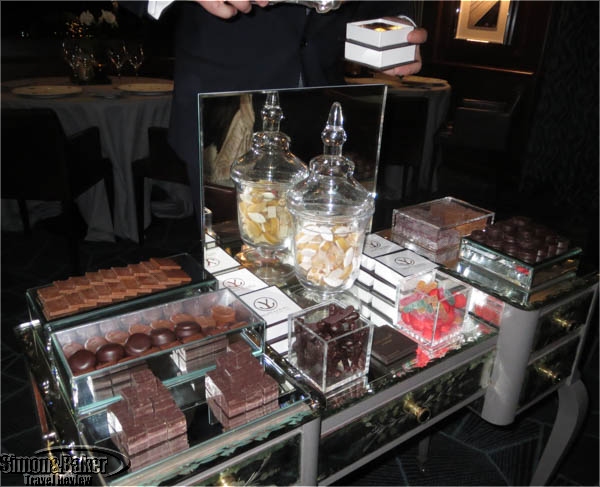
A cart of sweets to wrap up the meal
In addition to the well presented gourmet dinner we enjoyed and the exacting service, there were a myriad luxury touches, such as the blankets, cloth napkins with our amouse bouche, the orchid on our table, artistic dinnerware like the sea urchin shaped appetizer plates, quality nut snacks, perfectly timed courses to allow us to profit from the best views, and friendly and professional staff who kept us informed during the brief journey, that made the evening special. I would gladly take another cruise aboard the Don Juan II and recommend it to friends living or visiting Paris to celebrate a special occasion or just because.
by Editor | Aug 22, 2016 | Attractions, Luxury Travel
By Elena del Valle
Photos by Gary Cox
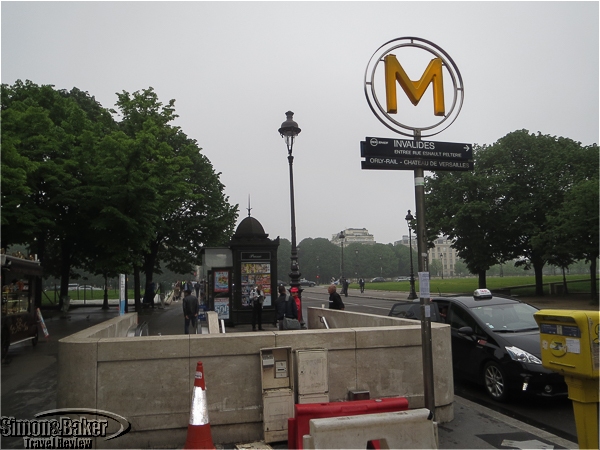
Our meeting place for the tour was the entrance of Les Invalides metro stop in Paris
Over the years I have visited Versailles, the famous palace established by Louis XIV near Paris, France, several times on my own and with large group tours. While the attraction itself was impressive the crowds were oppressive and the logistics to visit it cumbersome. On my most recent stay in the City of Lights, I tried a new approach. I placed myself in the hands of an organized small group program that started and ended in Paris. When I visited Versailles in the past I had to make my own way there from Paris. This time all I had to do was reach the meeting point in central Paris in the morning, and make my own lunch arrangements. The tour company took care of the rest. At the conclusion of the tour our small group returned to Paris together. I was pleased with the results. I appreciated and enjoyed my visit to the 787 hectare palatial estate much more than on most of my previous visits, and was able to discover areas open only to small escorted groups such as ours.
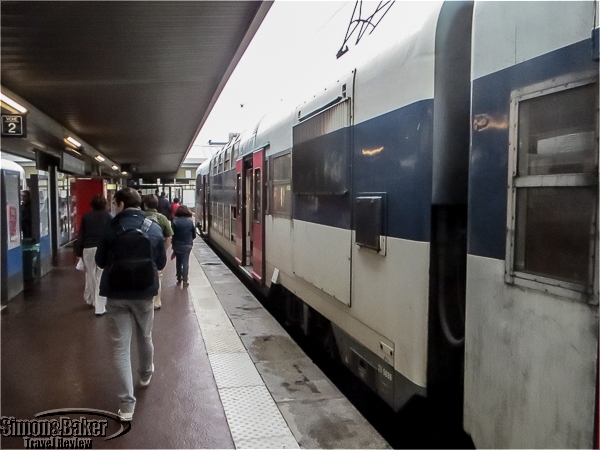
At the train station in Versaiilles
We met Herve Rudrauf, our English speaking French tour guide, by the entrance to Les Invalides RER train station in the tony seventh arrondissement near the heart of the city early morning on a spring Friday. It was pleasantly chilly. The sky was gray and overcast, threatening rain. We were thrilled to discover there were only four of us in the daylong (eight and a half hours) tour. The other two participants in the Full Day Versailles VIP Behind Locked Doors program, organized by City Wonders Tours (6-9 Trinity Street, Dublin, 1-800-358-1942, www.citywonders.com, Info@citywonders.com) were from the United States.
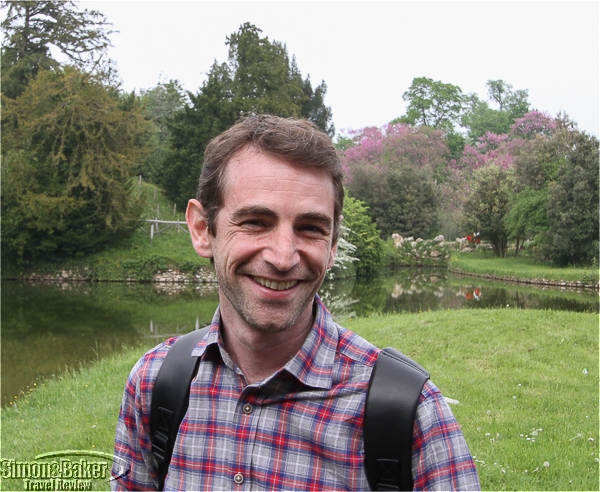
Herve Rudrauf, our tour guide, in the palace gardens
Following greetings, introductions, and instructions Herve handed each of us an RER train ticket and we descended the stairs to the station platform. A few minutes later, we boarded a crowded two level suburban train. It was necessary for our group to split up in order to find seats. Once at the Versailles train station, we found each other and walked together to the palace entrance where, thanks to our tour, we skipped the long admission line. We also had special access to select rooms, such as Marie Antoinette’s private theater, open only to escorted visitors. A staff person provided our group exclusive access.
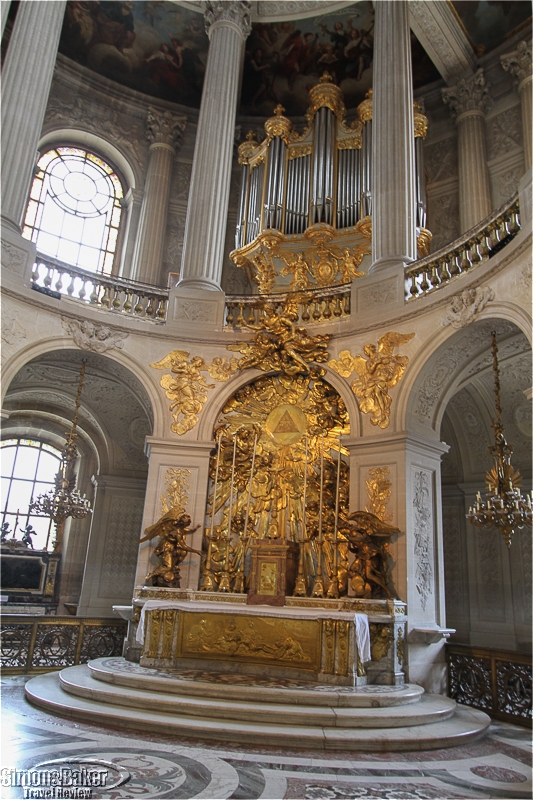
The Royal Chapel at Versailles
Despite the expedited entry and private visit, the interior of the palace was overcrowded with tourists, sometimes making it challenging for our small group to remain together, hear our guide, take photos and walk from one room to another without being separated. That was not surprising given that some 7.5 million people visit the opulent former royal residence each year, according to a Versailles spokesperson. Although the interior was 63,154 square meters large and the attraction employed as many as 1,000 staff, only 23,072 square meters of the former palace were open to the public, and some of those rooms and halls could only be visited with a guide. A representative from City Wonders indicated that as much as 70 percent of the palace interiors may be visited via an escorted tour.
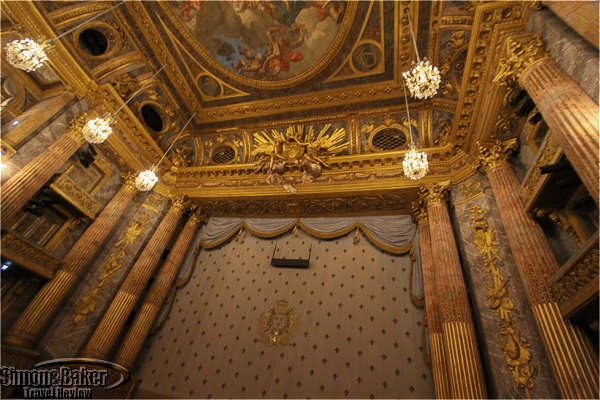
Our private visit of the Royal Opera was memorable.
Because of the uncertain and overcast weather it was a relatively quiet day, our guide explained to our surprise when we commented on the number of people all around us. As we made our way within the storied interior the cacophony of noises competed for our attention. Our eyes and imagination wondered. It was easy to become distracted. Thankfully Herve was efficient at keeping a speedy yet comfortable pace (although restroom breaks were limited and there was no time for the gift shop) while at the same time sharing engrossing information about the former royal residence and its famous occupants.

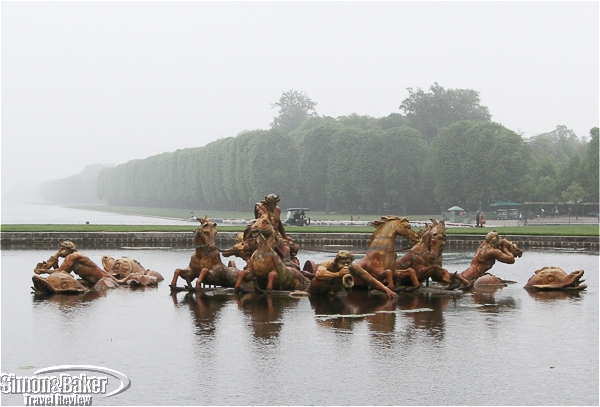
The palace gardens did not look their best because it was cloudy and rainy.
Anticipating a two hour break for lunch we had made reservations in advance at a gourmet restaurant in the village of Versailles. Unfortunately, by midday we were in the heart of the estate and too far away to return to the village for lunch so we begrudgingly cancelled our booking. Instead we made our way to one of the crowded restaurants within the property. While the service was speedy and efficient lunch was the most disappointing meal we had during that month long trip. We were so hungry after leaving the restaurant we attempted to buy something else at the nearby cafe only to find a slow moving long line and a limited selection of fast food items that appeared no better than what we had already sampled at the restaurant.
Part of what made the tour worthwhile, in addition to our tour guide’s knowledge and enthusiasm, was the access our small group had to areas of the former palace reserved for escorted tours such as ours. Despite huge crowds we had a chance to step behind the cordon at the Royal Chapel for a brief look. We had private visits of the Royal Opera in the main building and the Queen’s Theater in Le Petit Trianon, among of my favorite sections.
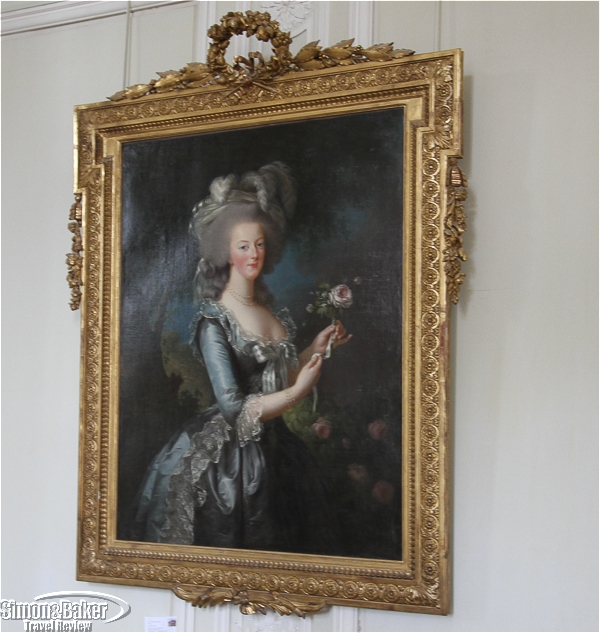
A painting of Marie Antoinette at Le Petit Trianon
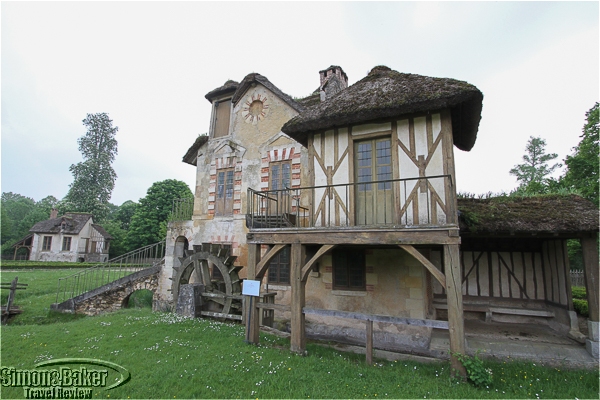
One of the houses in the Hamlet, part of the Versailles estate
After lunch we walked around the gardens, discovering a hidden grotto where the famous queen was said to spend quiet time alone. We also visited Le Petit Trianon, Marie Antoinette’s home away from home while at Versailles; and ambled around the Hamlet, a make believe village within the estate.
Perhaps because before studying to become a licensed tour guide Herve spent several years working as an actor his discussions about life at Versailles were engrossing and entertaining. His interest and passion about French history (he wrote his thesis on the representation of royal power in France), the royal families, and the intriguing stories of inhabitants of the former royal palace were contagious. By the end of the tour, our fellow travelers were asking him for recommendations of books about the history of Versailles and its previous inhabitants.
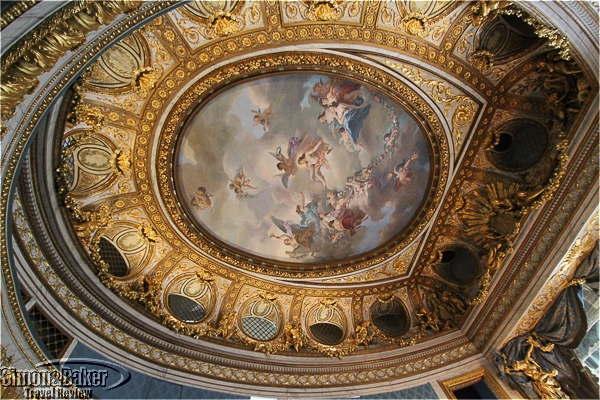
The ceiling of the Queen’s Theater at Le Petit Trianon
At the conclusion of the Versailles portion of the tour, a taxi, slightly delayed due to strikes, dropped us off at the Versailles train station where we boarded an RER return train to the city. City Wonders Tours, owned by Simone Gozzi, offered the Full Day Versailles VIP Behind Locked Doors tour Fridays and Saturdays only for a maximum of 15 people. The company won the award for the best Guides and Products in Paris 2016 from Get Your Guide. The highlight of the tour was Herve, our friendly, knowledgeable and enthusiastic tour guide who brought the history of Versailles alive. We especially liked the well orchestrated tour logistics, intimate size of our group, and access to private areas. In the future we would be well inclined to book another tour with the same company and the same guide.
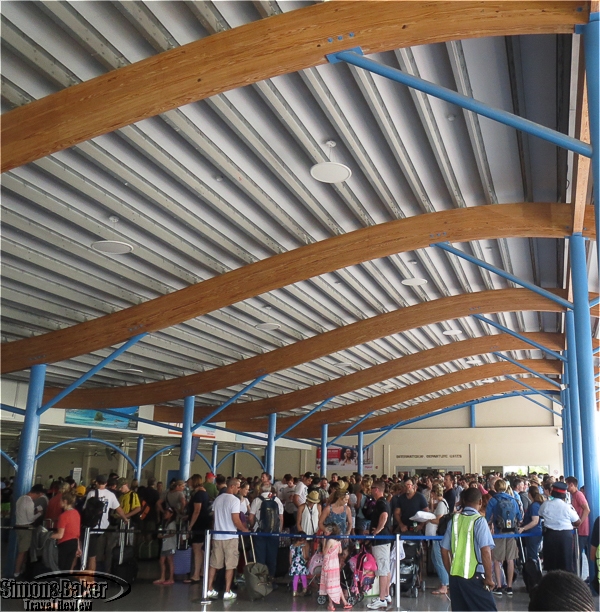
by Editor | May 9, 2016 | Luxury Travel
Article and photos by Elena del Valle

The crowd waiting for security at the Turks and Caicos airport from where I stood in line
It is a shame that the most salient memory I have of my recent trip to Providenciales in the tiny island nation of the Turks and Caicos some 573 miles from Miami, Florida is the unpleasant and frustrating departure. Given the upscale island’s high standards compared to other similar sized nations in the region and the number of wealthy foreign property owners I was taken aback by the conditions and process. Although I checked in online, had no wait at the airline counter, and arrived at the airport more than two hours in advance (the airline recommended passengers arrive two hours early as did the staff at my hotel) they called my flight for boarding while I was still in the security line.
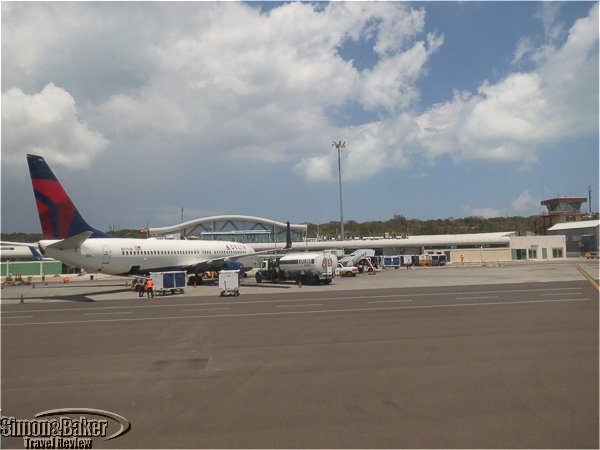
The airport in Providenciales, Turks and Caicos
I and dozens upon dozens of other travelers stood in a snaking queue that spanned five short lines in front of the entrance to the international departures immigration entrance and an additional line that ran back past the domestic airline counters beyond sight. The line was so thick a security guard insisted waiting passengers step away from the domestic airline counters so departing passengers for those flights could reach their counters. Although most passengers in the line, including families with small children, were patient and quiet, judging by appearances and overheard conversations, many were hot and sweaty (only the final portion of the line was within the air conditioned international departures area), surprised by the length of the line and long wait, and annoyed.
One uniformed staff woman in the main hall urged passengers to move forward in the line. Her military demeanor and biting tone did little to alleviate people’s stress and anxiety over possibly missing flights. Another uniformed staff woman guarded the entrance to the international departures area. While her tone was less strident than her colleague’s she was no more helpful. Two passengers near me in the queue were called by security over the loudspeakers while we were standing in line within the international departures area. When they tried to respond she insisted they remain in their place in line, dismissing their concerns. As they moved forward another staff person checked their documents and chided them for not responding to the security announcement. He rushed them to the head of the line.
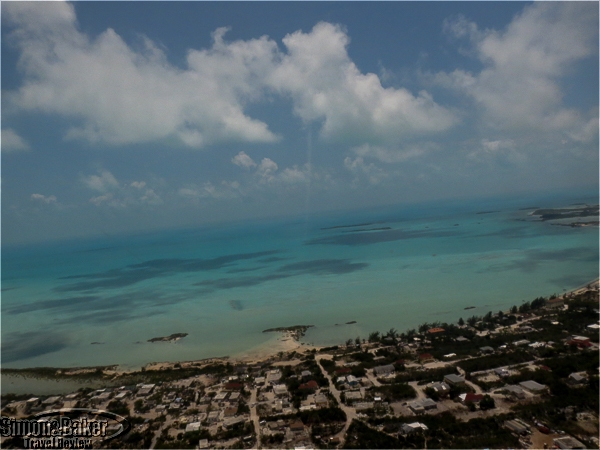
View of the coast just after takeoff
Representatives from two airlines came out to search for passengers for their departing flights. Once they found them, they too were rushed to the head of the line ahead of everyone else, delaying our processing. We watched as a family of passengers paid hundreds of dollars for expedited service. They too were bumped ahead of everyone else in the queue. I heard fellow passengers around me complain repeatedly, saying that such a situation was the equivalent of extortion.
At the end of the line only one of two passenger metal detectors was working, causing further delays as two lines merged into a single one. It did not help that everyone (as a foreign nation Turks and Caicos did not recognize the United States Transportation Security and Administration Precheck Program) was required to remove shoes and extract electronics from their carry on bag. To add to joy of the experience the staff looked tired and unhappy. They had little patience and were just shy of rude to passengers at the slightest question.
By the time I finished the process and I arrived at the single overcrowded shared departure hall the airline had called my flight for boarding three times. I rushed to my gate, wondering if all the passengers had made it on board as I had not seen any airport personnel searching for passengers for our flight in the line behind me. My departure from the Turks and Caicos was the slowest and least pleasant departure I recall having from an island in a long time, perhaps ever. While I had a good stay in Providenciales once aboard the plane I asked myself if I enjoyed my visit enough to counter the unpleasant departure process. I am still wondering.


























































